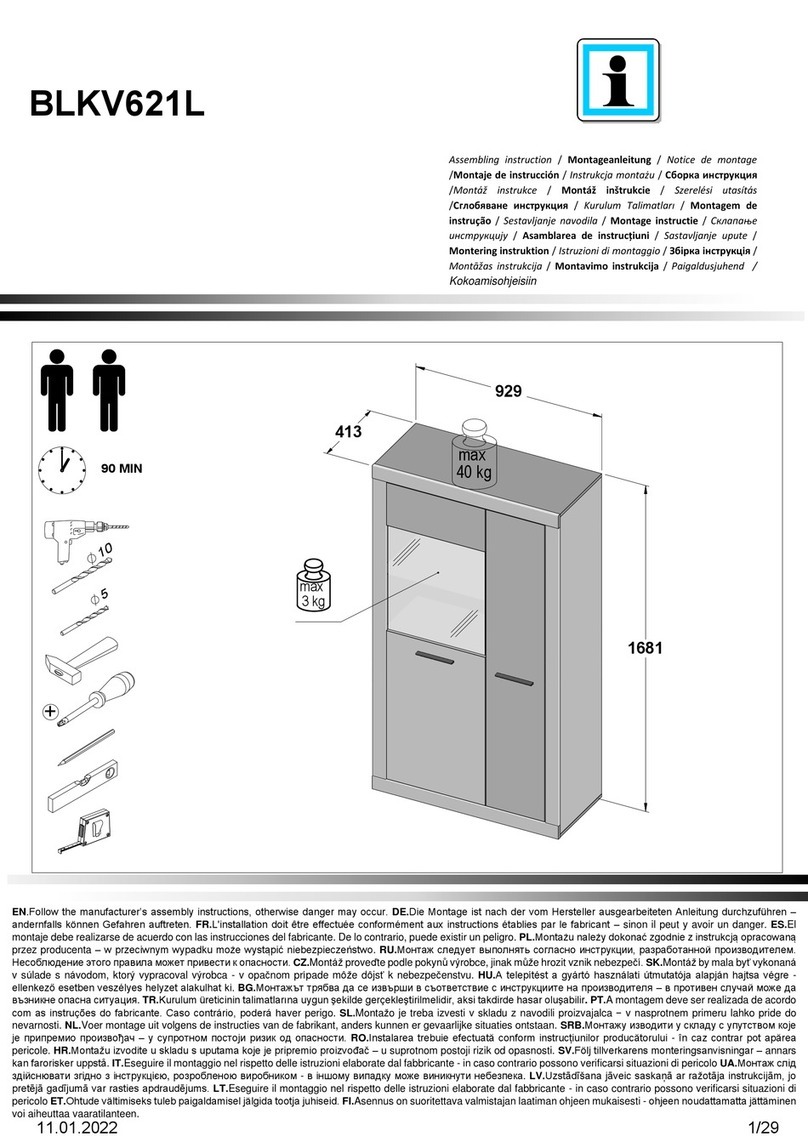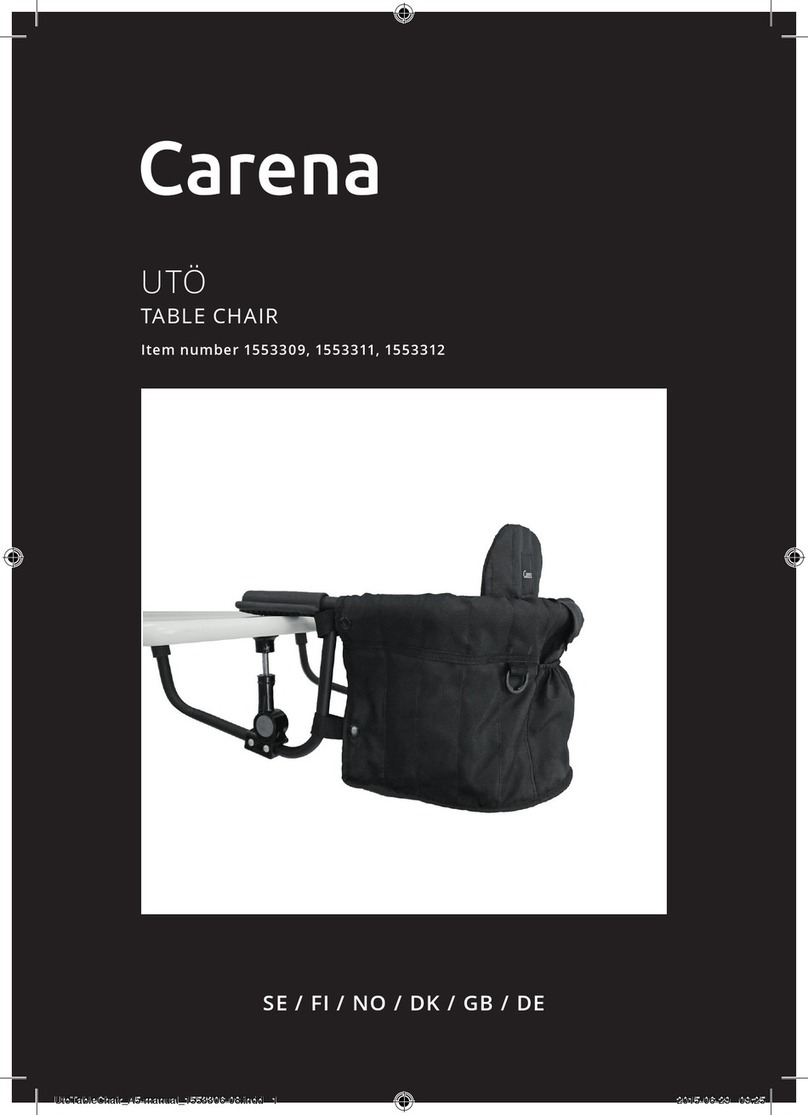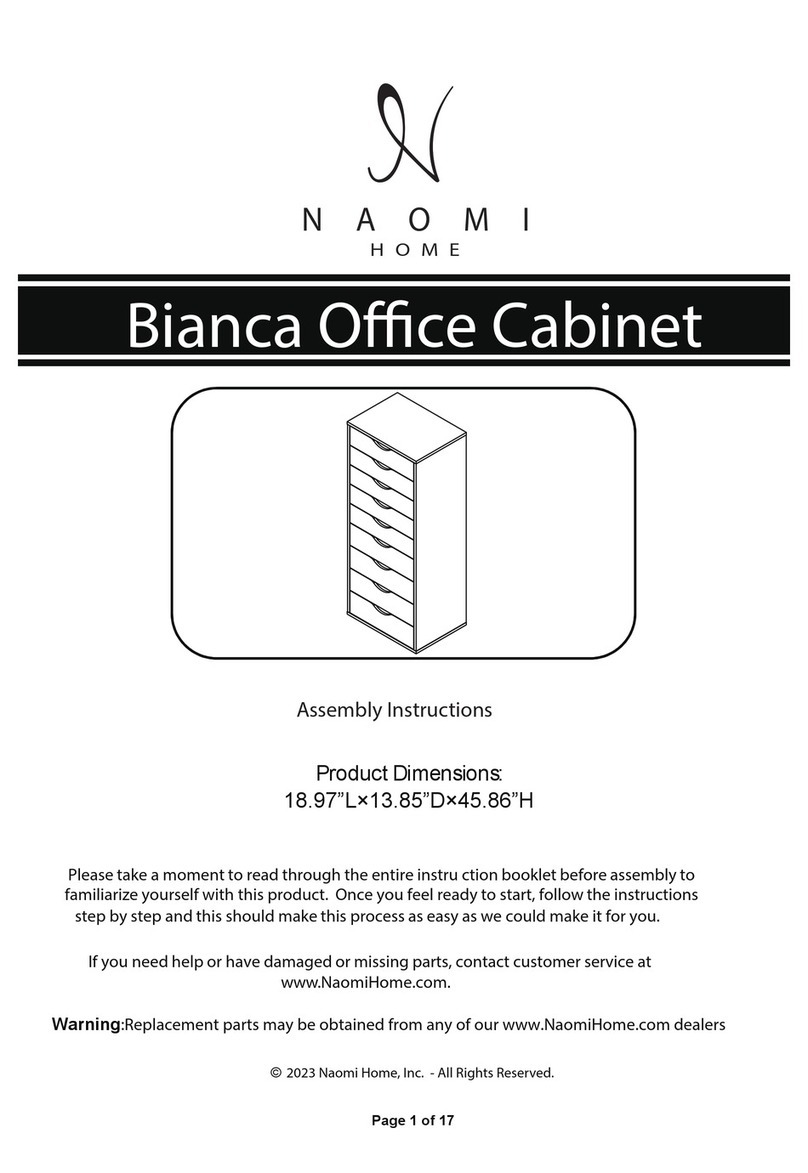CMCO Yale LMG Series Operating instructions

DE - Original Betriebsanleitung (gilt auch für Sonderausführungen)
Seilklemme
LMG
Columbus McKinnon Industrial Products GmbH
Yale-Allee 30
42329 Wuppertal
Deutschland

2
© 2016 Columbus McKinnon Industrial Products GmbH
Inhaltsverzeichnis
Vorwort...................................................................................................................................3
Bestimmungsgemässe Verwendung....................................................................................3
Sachwidrige Verwendung .....................................................................................................4
Montage .................................................................................................................................5
Prüfung vor der ersten Inbetriebnahme...............................................................................5
Prüfung vor Arbeitsbeginn ...................................................................................................6
Funktion / Betrieb..................................................................................................................6
Prüfung, Wartung & Reparatur .............................................................................................6
Transport, Lagerung, Ausserbetriebnahme und Entsorgung............................................7

3
© 2016 Columbus McKinnon Industrial Products GmbH
VORWORT
Produkte der CMCO Industrial Products GmbH sind nach dem Stand der Technik und den
anerkannten gültigen Regeln gebaut. Durch unsachgemäße Handhabungen können dennoch
bei der Verwendung der Produkte Gefahren für Leib und Leben des Benutzers oder Dritter
auftreten bzw. Beschädigungen am Hebezeug oder anderen Sachwerten entstehen.
Der Betreiber ist für die sach- und fachgerechte Unterweisung des Bedienpersonals
verantwortlich. Dazu ist die Betriebsanleitung von jedem Bediener vor der ersten
Inbetriebnahme sorgfältig zu lesen.
Diese Betriebsanleitung soll erleichtern, das Produkt kennenzulernen und die
bestimmungsgemäßen Einsatzmöglichkeiten zu nutzen. Die Betriebsanleitung enthält wichtige
Hinweise, um das Produkt sicher, sachgerecht und wirtschaftlich zu betreiben. Ihre Beachtung
hilft Gefahren zu vermeiden, Reparaturkosten und Ausfallzeiten zu vermindern und die
Zuverlässigkeit und Lebensdauer des Produktes zu erhöhen. Die Betriebsanleitung muss
ständig am Einsatzort des Produktes verfügbar sein. Neben der Betriebsanleitung und den im
Verwenderland und an der Einsatzstelle geltenden verbindlichen Regelungen zur
Unfallverhütungsvorschrift sind auch die anerkannten Regeln für sicherheits- und
fachgerechtes Arbeiten zu beachten.
Das Personal für Bedienung, Wartung oder Reparatur des Produktes muss die Anweisungen
in dieser Betriebsanleitung lesen, verstehen und befolgen.
Die beschriebenen Schutzmaßnahmen führen nur dann zu der erforderlichen Sicherheit, wenn
das Produkt bestimmungsgemäß betrieben und entsprechend den Hinweisen installiert bzw.
gewartet wird. Der Betreiber ist verpflichtet, einen sicheren und gefahrlosen Betrieb zu
gewährleisten.
BESTIMMUNGSGEMÄSSE VERWENDUNG
Das Anschlagmittel dient dem sicheren und schonenden Greifen, Ziehen und Spannen von
nicht ummantelten Drahtseilen (oder Kabeln) und Metallstangen aller Art, in Abhängigkeit von
Seildurchmesser und Oberflächenbeschaffenheit, bis zu einer Materialfestigkeit von max.
1770 N/mm² (LMG II-X bis zu max. 1960 N/mm²).
ACHTUNG: Das Gerät darf nicht zum Heben von Lasten verwendet werden.
Die Seilklemme ist ein geeignetes Hilfsmittel zur Handhabung der Original Yaletrac-Seile mit
Seildurchmessern von 8,4 mm, 11,5 mm und 16 mm. Aufgrund vieler verschiedener auf dem
Markt erhältlichen Kabel- bzw. Drahtseiltypen aus unterschiedlichsten Materialien und mit
verschiedensten Oberflächen, kann keine generelle Garantie dafür übernommen werden,
dass jedes Drahtseil, Kabel oder jede Metallstange, deren/dessen Durchmesser innerhalb des
Greifbereichs der Seilklemme liegt, ohne Rutschen gegriffen werden kann. Bei Unklarheiten
sollte mit dem Hersteller Rücksprache genommen werden.
Eine andere oder darüber hinausgehende Benutzung gilt als nicht bestimmungsgemäß. Für
hieraus resultierende Schäden haftet Columbus McKinnon Industrial Products GmbH nicht.
Das Risiko trägt allein der Anwender bzw. Betreiber.
Die auf dem Gerät angegebene Tragfähigkeit (WLL) ist die maximale Last, die auf die Zugöse
einwirken darf.
Der Gebrauch und die Wartung des verwendeten Drahtseils muss anhand der DIN 15020
Blatt 2 überwacht werden.
Beim Anschlagen des Gerätes ist vom Bediener darauf zu achten, dass das Hebezeug so
bedient werden kann, dass der Bediener weder durch das Gerät selbst noch durch das
Tragmittel oder die Last gefährdet wird.

4
© 2016 Columbus McKinnon Industrial Products GmbH
Der Bediener darf eine Lastbewegung erst dann einleiten, wenn er sich davon überzeugt hat,
dass die Last richtig angeschlagen ist und sich keine Personen im Gefahrenbereich aufhalten.
Mit dem Anschlagmittel darf jeweils nur ein Kabel oder Seil bzw. eine Stange gefasst werden.
Das gegriffene Gut muss über die gesamte Länge der Klemmbacken mittig in der
Führungsrille liegen.
Lasten nicht über längere Zeit oder unbeaufsichtigt in gespanntem Zustand belassen.
Ist die gegriffene Last nicht auf gesamter Länge ausreichend einsehbar, hat sich der Bediener
um Hilfestellung zu bemühen.
Das Anschlagmittel kann in einer Umgebungstemperatur zwischen –40°C und +100°C
eingesetzt werden. Bei Extrembedingungen muss mit dem Hersteller Rücksprache genommen
werden.
Vor dem Einsatz des Anschlagmittels in besonderen Atmosphären (hohe Feuchtigkeit, salzig,
ätzend, basisch) oder der Handhabung gefährlicher Güter (z.B. feuerflüssige Massen,
radioaktive Materialien) ist mit dem Hersteller Rücksprache zu halten.
Das Ziehen/Spannen muss immer langsam, vorsichtig und bodennah durchgeführt werden.
Durchrutschende Seile, wie sie z.B. bei einer ruckartigen Laststeigerung auftreten können,
können die Verzahnung zerstören.
Zur bestimmungsgemäßen Verwendung gehört neben der Beachtung der Betriebsanleitung
auch die Einhaltung der Wartungsanleitung.
Bei Funktionsstörungen oder abnormalen Betriebsgeräuschen ist das Hebezeug sofort außer
Betrieb zu setzen.
SACHWIDRIGE VERWENDUNG
(Nicht vollständige Auflistung)
Die maximal zulässige Zugkraft (WLL) darf nicht überschritten werden.
Das Entfernen oder Verdecken von Beschriftungen (z.B. durch Überkleben), Warnhinweisen
oder dem Typenschild ist untersagt.
Beim Transport der Last ist eine Pendelbewegung und das Anstoßen an Hindernisse zu
vermeiden.
Die Last darf nicht in Bereiche bewegt werden, die für den Bediener nicht einsehbar sind.
Nötigenfalls hat er sich um Hilfestellung zu bemühen.
Schrägzug, d.h. seitliche Belastung der Zugöse, ist verboten. Die eingeleiteten Zugkräfte
dürfen nur parallel zum geklemmten Gut verlaufen.

5
© 2016 Columbus McKinnon Industrial Products GmbH
Das Anschlagmittel darf nicht zum Heben von Lasten benutzt werden.
Ein ohne Rücksprache mit dem Hersteller verändertes Gerät darf nicht benutzt werden.
Die Benutzung des Anschlagmittels zum Transport von Personen ist verboten.
Es dürfen nur Geräte, die mit Haken mit Sicherheitsbügeln ausgerüstet sind, in die Zugöse
gehängt werden. Dabei ist darauf zu achten, dass der Haken nicht zu groß dimensioniert ist.
Die Öse muss mittig im Hakengrund liegen und der Haken muss in der Öse frei beweglich
sein.
Es darf nicht mehr als ein Seil/Kabel oder eine Stange gleichzeitig gegriffen werden.
MONTAGE
ACHTUNG: Das Gerät darf nur zum Hantieren von nichtummantelten Drahtseilen (auch
nichtummantelten Kabeln) und Metallstangen aller Art eingesetzt werden.
Durch Drücken der Zugöse gegen die Federvorspannung in Richtung des festgehaltenen
Klemmenkörpers wird das Anschlagmittel geöffnet. In dem Zustand kann es auf das gradlinig
ausliegende oder gespannte Drahtseil/Kabel oder die Metallstange geklemmt werden. Durch
Nachlassen des auf die Zugöse ausgeübten Druckes schließen sich die Klemmbacken, die
Zugöse wird zurück gezogen und die Federvorspannung sorgt dafür, dass das Anschlagmittel
auch ohne Zugbelastung auf dem Material hält.
ACHTUNG: Nach dem Einlegen des Materials seine Lage kontrollieren. Es muss auf
ganzer Länge der Klemmbacken mittig in der Führungsrille liegen.
Durch Befestigen eines Zugseils mit Sicherheitshaken an der Zugöse kann das Material
gezogen/gespannt werden. Nach Beenden des Arbeitsvorgangs kann das Zugseil von der
Zugöse genommen werden. Durch erneutes Zusammendrücken der Zugöse in Richtung
Klemmenkörper werden die Klemmbacken des Anschlagmittels geöffnet und das Material wird
wieder freigegeben
PRÜFUNG VOR DER ERSTEN INBETRIEBNAHME
Vor der ersten Inbetriebnahme, vor der Wiederinbetriebnahme und nach grundlegenden
Änderungen ist das Produkt einschließlich der Tragkonstruktion einer Prüfung durch eine
befähigte Person* zu unterziehen. Diese Prüfung besteht im Wesentlichen aus einer Sicht-
und Funktionsprüfung. Diese Prüfungen sollen sicherstellen, dass sich das Hebezeug in
einem sicheren Zustand befindet, ordnungsgemäß aufgestellt und betriebsbereit ist und
gegebenenfalls Mängel bzw. Schäden festgestellt und behoben werden.
*Als befähigte Personen können z.B. die Wartungsmonteure des Herstellers oder Lieferanten
angesehen werden. Der Unternehmer kann aber auch entsprechend ausgebildetes
Fachpersonal des eigenen Betriebes mit der Prüfung beauftragen.

6
© 2016 Columbus McKinnon Industrial Products GmbH
PRÜFUNG VOR ARBEITSBEGINN
Überprüfung des Anschlagmittels
Das gesamte Anschlagmittel ist auf Beschädigungen, Risse, Verformungen, Verschleiß und
Korrosionsnarben hin zu überprüfen.
Die Oberfläche der Last muss möglichst farb-, schmutz-, zunder- und beschichtungsfrei sein,
so dass der Kontakt der Klemmbacken zur Last nicht behindert wird.
Die Klemmbacken auf Verschleiß und Mängel prüfen. Beide Backen müssen ein sauberes
Profil besitzen.
Die Federvorspannung überprüfen. Bereits ohne auf die Zugöse einwirkende Zugkräfte muss
die Klemmbacke einen deutlich spürbaren Anpressdruck aufweisen.
Das Anschlagmittel muss sich leichtgängig offnen und schließen lassen.
FUNKTION /BETRIEB
Aufstellung, Wartung, Bedienung
Mit der Aufstellung, Wartung oder der selbstständigen Bedienung der Hebezeuge dürfen nur
Personen betraut werden, die mit den Geräten vertraut sind.
Sie müssen vom Unternehmer zum Aufstellen, Warten oder Betätigen der Geräte beauftragt
sein. Zudem müssen dem Bediener die Regeln der UVV bekannt sein.
PRÜFUNG,WARTUNG &REPARATUR
Laut bestehenden nationalen/internationalen Unfallverhütungs- bzw. Sicherheitsvorschriften
müssen Lastaufnahmemittel
• gemäß der Gefahrenbeurteilung des Betreibers,
• vor der ersten Inbetriebnahme,
• vor der Wiederinbetriebnahme nach Stilllegung
• nach grundlegenden Änderungen,
• jedoch mindestens 1 x jährlich durch eine befähigte Person geprüft werden.
ACHTUNG: Die jeweiligen Einsatzbedingungen (z.B. in der Galvanik) können kürzere
Prüfintervalle notwendig machen.
Reparaturarbeiten dürfen nur von Fachwerkstätten, die Original Yale Ersatzteile verwenden,
durchgeführt werden. Die Prüfung (im Wesentlichen Sicht- und Funktionsprüfung) hat sich auf
die Vollständigkeit und Wirksamkeit der Sicherheitseinrichtungen sowie auf den Zustand des
Gerätes, der Tragmittel, der Ausrüstung und der Tragkonstruktion hinsichtlich Beschädigung,
Verschleiß, Korrosion oder sonstigen Veränderungen zu erstrecken.
Die Inbetriebnahme und die wiederkehrenden Prüfungen müssen dokumentiert werden (z.B.
in der CMCO-Werksbescheinigung).
Auf Verlangen sind die Ergebnisse der Prüfungen und die sachgemäße
Reparaturdurchführung nachzuweisen. Ist das Hebezeug (ab 1t Hubgewicht) an oder in einem
Fahrwerk eingebaut und wird mit dem Hebezeug eine gehobene Last in eine oder mehrere
Richtungen bewegt, wird die Anlage als Kran betrachtet und es sind ggf. weitere Prüfungen
durchzuführen.
Lackbeschädigungen sind auszubessern, um Korrosion zu vermeiden. Alle Gelenkstellen und
Gleitflächen sind leicht zu schmieren. Bei starker Verschmutzung ist das Gerät zu reinigen.
Spätestens nach 10 Jahren muss das Gerät einer Generalüberholung unterzogen werden.
ACHTUNG: Der Austausch von Bauteilen zieht zwangsläufig eine anschließende
Prüfung durch eine befähigte Person nach sich!

7
© 2016 Columbus McKinnon Industrial Products GmbH
Prüfung des Drahtseils
Maßgebend für die Wartung und Prüfung des Drahtseiles sind die DIN 15020 Blatt 2
“Grundsätze für Seiltriebe, Überwachung und Gebrauch”, sowie die gültigen nationalen und
internationalen Vorschriften des Betreiberlandes.
Reparaturen dürfen nur von autorisierten Fachwerkstätten, die Original Yale Ersatzteile
verwenden, durchgeführt werden.
Nach einer erfolgten Reparatur sowie nach längerer Standzeit ist das Hebezeug vor der
Wiederinbetriebnahme erneut zu prüfen.
Die Prüfungen sind vom Betreiber zu veranlassen.
TRANSPORT,LAGERUNG,AUSSERBETRIEBNAHME UND
ENTSORGUNG
Beim Transport des Gerätes sind folgende Punkte zu beachten:
• Gerät nicht stürzen oder werfen, immer vorsichtig absetzen.
• Geeignete Transportmittel verwenden. Diese richten sich nach den örtlichen Gegebenheiten.
Bei der Lagerung oder der vorübergehenden Außerbetriebnahme des Gerätes sind
folgende Punkte zu beachten:
• Das Gerät an einem sauberen und trockenen Ort lagern.
• Das Gerät inkl. aller Anbauteile vor Verschmutzung, Feuchtigkeit und Schäden durch eine
geeignete Abdeckung schützen.
• Soll das Gerät nach der Außerbetriebnahme wieder zum Einsatz kommen, ist es zuvor einer
erneuten Prüfung durch eine befähigte Person zu unterziehen.
Entsorgung
Nach Außerbetriebnahme sind die Teile des Gerätes entsprechend den gesetzlichen
Bestimmungen der Wiederverwertung zuzuführen bzw. zu entsorgen.
Weitere Informationen und Betriebsanleitungen zum Download sind unter
www.cmco.eu zu finden!

8
© 2016 Columbus McKinnon Industrial Products GmbH
Modell
Model
Modéle
Zugkraft
Pulling force
Force
de traction
[daN]
Für Seildurchmesser
For wire rope diameter
Pour diamètre de câble
[mm]
Zugöse
Eye opening
Œil
d’accrochage
[mm]
Gewicht
Weight
Poids
[kg]
LMG I 2.000 5 - 15 31 x 44 1,6
LMG II 3.000 8 - 20 31 x 44 2,9
LMG II-X 3.000 8 - 20 31 x 44 2,9
LMG III 5.000 18 - 32 66 x 93 9,5
Tab. 1

9
© 2016 Columbus McKinnon Industrial Products GmbH
EN - Translated Operating Instructions (Also applicable for special versions)
Cable grip
LMG
Columbus McKinnon Industrial Products GmbH
Yale-Allee 30
42329 Wuppertal
Germany

10
© 2016 Columbus McKinnon Industrial Products GmbH
Table of Contents
Introduction .........................................................................................................................11
Correct Operation................................................................................................................11
Incorrect Operation .............................................................................................................12
Assembly .............................................................................................................................13
Inspection Before Initial Operation.....................................................................................13
Inspection Before Starting Work ........................................................................................14
Operation .............................................................................................................................14
Inspection, Service & Repair ..............................................................................................14
Transport, Storage, Decommissioning and Disposal .......................................................15

11
© 2016 Columbus McKinnon Industrial Products GmbH
INTRODUCTION
Products of CMCO Industrial Products GmbH have been built in accordance with the state-of-
the-art and generally accepted engineering standards. Nonetheless, incorrect handling when
using the products may cause dangers to life and limb of the user or third parties and/or
damage to the hoist or other property.
The operating company is responsible for the proper and professional instruction of the
operating personnel. For this purpose, all operators must read these operating instructions
carefully prior to the initial operation.
These operating instructions are intended to acquaint the user with the product and enable
him to use it to the full extent of its intended capabilities. The operating instructions contain
important information on how to operate the product in a safe, correct and economic way.
Acting in accordance with these instructions helps to avoid dangers, reduce repair costs and
downtimes and to increase the reliability and lifetime of the product. The operating instructions
must always be available at the place where the product is operated. Apart from the operating
instructions and the accident prevention act valid for the respective country and area where
the product is used, the commonly accepted regulations for safe and professional work must
also be adhered to.
The personnel responsible for operation, maintenance or repair of the product must read,
understand and follow these operating instructions.
The indicated protective measures will only provide the necessary safety, if the product is
operated correctly and installed and/or maintained according to the instructions. The operating
company is committed to ensure safe and trouble-free operation of the product.
CORRECT OPERATION
The lifting tackle is a device for safe and non-marring gripping, pulling and tensioning of
uncoated wire ropes (or cables) and metal rods in all forms up to a tensile strength of 1770
N/mm² (LMG II-X up to max. 1960 N/mm²), depending on the rope diameter and surface
properties.
ATTENTION: The unit must not be used for lifting loads.
The cable grip is a suitable tool for handling original Yaletrac ropes with rope diameters of 8.4
mm, 11.5 mm and 16 mm. In view of the many different cable and wire types of the most
varied materials and surfaces available in the market, no general guarantee can be given that
every wire rope, cable or metal rod with a diameter within the capacity of the cable grip can be
gripped without slipping. Consult the manufacturer in case clarification is required.
Any different or exceeding use is considered incorrect. Columbus McKinnon Industrial
Products GmbH will not accept any liability for damage resulting from such use. The risk is
borne by the user or operating company alone.
The load capacity indicated on the unit is the maximum working load limit (WLL) that may act
on the eye.
The use and maintenance of the wire rope must be monitored with the help of DIN 15020
Sheet 2.
The operator must ensure that the hoist is attached in a manner that makes it possible to
operate the hoist without exposing himself or other personnel to danger by the unit itself, the
suspension or the load.
The operator may start moving the load only after it has been attached correctly and all
persons are clear of the danger zone.
Only one cable or rope or bar may be gripped at a time with the lifting tackle. The gripped load
must lie centrally in the guide groove over the entire length of the clamping jaws.
Loads must not be left unattended or remain clamped for a longer period of time.

12
© 2016 Columbus McKinnon Industrial Products GmbH
If the gripped load is not sufficiently visible over the entire length, the operator must ensure he
is given help.
The lifting tackle may be used at ambient temperatures between –40°C and +100°C. Consult
the manufacturer in the case of extreme working conditions.
Prior to operation of the lifting tackle in special atmospheres (high humidity, salty, caustic,
alkaline) or handling hazardous goods (e.g. molten compounds, radioactive materials), consult
the manufacturer for advice.
Always pull/tension slowly, carefully and close to the ground. Slipping ropes as they may be
caused by a sudden load increase, for example, may destroy the teething.
Correct operation involves compliance with the operating instructions and in addition also
compliance with the maintenance instructions.
In case of functional defects or abnormal operating noise, stop using the hoist immediately.
INCORRECT OPERATION
(List not complete)
Do not exceed the max. permissible pulling force (WLL).
Removing or covering labels (e.g. by adhesive labels), warning information signs or the
identity plate is prohibited.
When transporting loads ensure that the load does not swing or come into contact with other
objects.
The load must not be moved into areas which are not visible to the operator. If necessary, he
must ensure he is given help.
Side pull, i. e. side loading of the eye is forbidden. Any tensile forces transmitted must only run
parallel to the clamped load.

13
© 2016 Columbus McKinnon Industrial Products GmbH
The lifting tackle must not be used for lifting loads.
A unit changed without consulting the manufacturer must not be used.
Do not use the lifting tackle for the transportation of people.
Only units fitted with hooks with safety latches must be suspended in the eye. Make sure that
the hook is not too large. The eye must be seated centrally in the saddle of the hook and the
hook must be freely articulating in the eye.
Not more than one rope/cable or rod may be gripped at a time.
ASSEMBLY
ATTENTION: The unit may only be used for handling uncoated wire ropes (also
uncoated cables) and metal rods of any type.
The lifting tackle is opened by pressing the eye against the pressure force in the direction of
the held clamp body. In this condition, it can be clamped onto the wire rope/cable which is
tensioned or lying straight or onto the metal rod. The clamping jaws close when the pressure
acting on the eye is reduced, the eye is retracted and the spring tension ensures that the lifting
tackle remains attached on the material also without any pulling force.
ATTENTION: After inserting the material, check its position. It must lie centrally in the
guide groove over the entire length of the clamping jaws.
The material can be pulled/tensioned by fitting a rope with safety hook to the eye. After
completing the work process, the rope can be removed from the eye. The clamping jaws of the
lifting tackle are opened by pressing the eye again in the direction of the clamp body and the
material is released again.
INSPECTION BEFORE INITIAL OPERATION
Prior to initial operation, before it is put into operation again and after substantial changes, the
product including the supporting structure must be inspected by a competent person*. The
inspection mainly consists of a visual inspection and a function check. These inspections are
intended to establish that the hoist is in a safe condition, has been set up appropriately and is
ready for operation and that any defects or damage are detected and eliminated, as required.
*Competent persons may be, for example, the maintenance engineers of the manufacturer or
the supplier. However, the company may also assign performance of the inspection to its own
appropriately trained specialist personnel.

14
© 2016 Columbus McKinnon Industrial Products GmbH
INSPECTION BEFORE STARTING WORK
Inspection of the lifting tackle
Check the complete lifting tackle for damage, cracks, deformations, wear and corrosion marks.
Ensure that the surface of the load is free from paint, contamination and scale and is not
coated, so that the clamping jaws can make good contact with the surface of the load.
Check the clamping jaws for wear and defects. Both jaws must have clean profiles.
Check the spring tension. The clamping jaw must have a clearly noticeable pressure force
already without any tensile forces acting on the eye.
The lifting tackle must open and close easily and freely.
OPERATION
Installation, service, operation
Operators delegated to install, service or independently operate the hoist must have had
suitable training and be competent. Operators are to be specifically nominated by the
company and must be familiar with all relevant safety regulations of the country of use.
INSPECTION,SERVICE &REPAIR
According to national and international accident prevention and safety regulations load lifting
attachments must be inspected:
• in accordance with the risk assessment of the operating company
• prior to initial operation
• before the unit is put into service again following a shut down
• after substantial changes
• however, at least once per year, by a competent person.
ATTENTION: Actual operating conditions (e.g. operation in galvanizing facilities) can
dictate shorter inspection intervals.
Repair work may only be carried out by a specialist workshop that uses original Yale spare
parts. The inspection (mainly consisting of a visual inspection and a function check) must
determine that all safety devices are complete and fully operational and cover the condition of
the unit, suspension, equipment and supporting structure with regard to damage, wear,
corrosion or any other alterations.
Initial operation and recurring inspections must be documented (e.g. in the CMCO works
certificate of compliance).
If required, the results of inspections and appropriate repairs must be verified. If the hoist (from
1 t lifting weight) is fitted on or in a trolley and if the hoist is used to move a lifted load in one or
several directions, the installation is considered to be a crane and the further inspections must
be carried out, as required.
Paint damage should be touched up in order to avoid corrosion. All joints and sliding surfaces
should be slightly greased. In the case of heavy contamination, the unit must be cleaned.
The unit must be given a general overhaul after 10 years, at the latest.
ATTENTION: After the replacement of components, a subsequent inspection by a
competent person is obligatory!

15
© 2016 Columbus McKinnon Industrial Products GmbH
Inspection of the wire rope
DIN 15020 sheet 2 “Principles Relating to Rope Drives; Supervision during Operation” and the
relevant international and national regulations of the country of use are definitive for the
maintenance and inspection of wire ropes.
Repairs may only be carried out by authorized specialist workshops that use original
Yale spare parts.
After repairs have been carried out and after extended periods of non-use, the hoist must be
inspected again before it is put into service again.
The inspections have to be initiated by the operating company.
TRANSPORT,STORAGE,DECOMMISSIONING AND DISPOSAL
Observe the following for transporting the unit:
• Do not drop or throw the unit, always deposit it carefully.
• Use suitable transport means. These depend on the local conditions.
Observe the following for storing or temporarily taking the unit out of service:
• Store the unit at a clean and dry place.
• Protect the unit incl. all accessories against contamination, humidity and damage by means
of a suitable cover.
• If the unit is to be used again after it has been taken out of service, it must first be inspected
again by a competent person.
Disposal
After taking the unit out of service, recycle or dispose of the parts of the unit in accordance
with the legal regulations.
Further information and operating instructions for download can be found at
www.cmco.eu!

16
© 2016 Columbus McKinnon Industrial Products GmbH
Modell
Model
Modéle
Zugkraft
Pulling force
Force
de traction
[daN]
Für Seildurchmesser
For wire rope diameter
Pour diamètre de câble
[mm]
Zugöse
Eye opening
Œil
d’accrochage
[mm]
Gewicht
Weight
Poids
[kg]
LMG I 2.000 5 - 15 31 x 44 1,6
LMG II 3.000 8 - 20 31 x 44 2,9
LMG II-X 3.000 8 - 20 31 x 44 2,9
LMG III 5.000 18 - 32 66 x 93 9,5
Tab. 1

17
© 2016 Columbus McKinnon Industrial Products GmbH
FR - Traduction de mode d’emploi (Cela s‘applique aussi aux autres versions)
Pinces serre-câble
LMG
Columbus McKinnon Industrial Products GmbH
Yale-Allee 30
42329 Wuppertal
Allemagne

18
© 2016 Columbus McKinnon Industrial Products GmbH
Table des Matières
Introduction .........................................................................................................................19
Utilisation correcte..............................................................................................................19
Utilisation incorrecte...........................................................................................................20
Montage ...............................................................................................................................21
Inspection Avant Mise En Service......................................................................................21
Inspection Avant De Commencer A Travailler...................................................................22
Emploi ..................................................................................................................................22
Inspection, service et réparation........................................................................................22
Transport, Stockage, Mise Hors Service et destruction....................................................23

19
© 2016 Columbus McKinnon Industrial Products GmbH
INTRODUCTION
Les produits de CMCO Industrial Products GmbH ont été construits conformément aux
normes techniques de pointe et généralement reconnues. Néanmoins, une utilisation
incorrecte des produits peuvent engendrer un accident grave ou fatal de l'utilisateur ou un
tiers ou encore des dommages pour le palan ou d'autres biens.
La société propriétaire est chargée de la formation appropriée et professionnelle des
opérateurs. À cette fin, tous les opérateurs doivent lire ces instructions d'utilisation
soigneusement avant l'utilisation initiale. Ces instructions visent à familiariser l'opérateur avec
le produit et lui permettre de l'utiliser dans toute la mesure de ses capacités. Le manuel
d'instructions contient des renseignements importants sur la façon d'utiliser le produit d'une
manière sûre, économique et correcte. Agir conformément à ces instructions aide à éviter les
dangers, de réduire les coûts de réparation et les périodes d'indisponibilité et d'augmenter la
fiabilité et la durée de vie du produit. Le manuel d'instruction doit toujours être disponible à
l'endroit où le produit est utilisé. Mis à part le mode d' emploi et les règles de prévention des
accidents valables pour le pays et la zone où le produit est utilisé, le règlement communément
reconnu pour un travail professionnel et sûr doit également être respecté. Le personnel
responsable de l'utilisation, de l'entretien ou des réparations du produit doit lire, comprendre et
suivre le manuel d'instructions. Les mesures de protection indiquées ne fourniront la sécurité
nécessaire que si le produit est utilisé correctement, installé et entretenu conformément aux
instructions. La société propriétaire s'engage à assurer un fonctionnement sûr et sans
problème du produit.
UTILISATION CORRECTE
L'accessoire de levage est destiné à la préhension sure est non aggressive de câble non
revetu ou de barres en métal dont la dureté n'excède pas 1770N/mm² (LMG II-X 1960N/mm²),
dépendant du Ø du fil ainsi que des propriétés de surface.
ATTENTION : l'appareil ne doit pas être utilisé pour soulever des charges
Les machoires sont adaptées pour manipuler les cables Yaletrac de diamètre 8,4mm, 11,5mm
ou 16mm. Au regard de la variété de câbles de matériaux et de surfaces différents disponibles
sur le marché, aucune garantie générale ne peut être donnée stipulant que chaque cable
métallique conforme en diamètre et en capacité peut être tenu sans glissement par les
machoires. Consulter le fabricant en cas de besoin.
Toute utilisation différente ou hors des limites est considérée comme incorrecte. Columbus
McKinnon Industrial Products GmbH n'acceptera aucune responsabilité pour les dommages
résultant de cette utilisation. Le risque est seulement pris par l'utilisateur ou la société
propriétaire.
La capacité de charge indiquée sur l'appareil est la charge maximum utile (CMU) qui peut être
appliquée sur l'anneau.
L'utilisation et l'entretien du câble utilisé doit être réalisé sur la base de la norme DIN 15020
partie 2.
L'opérateur doit s'assurer que le palan est fixé de telle manière qu'il est possible de le faire
fonctionner sans exposer l'opérateur ou d'autres personnes à un danger provenant de
l'appareil, de l'élinguage ou de la charge.
L'utilisateur ne peut commencer à déplacer la charge qu’après l'avoir attaché correctement, et
qu'aucune personne ne se trouve dans la zone de danger.
Un seul câble ou barre peut-être serré en même temps dans la pince. La charge serrée doit
se situer au centre de la rainure de guidage et sur la longueur totale des machoires de
serrage.

20
© 2016 Columbus McKinnon Industrial Products GmbH
Les charges ne doivent pas être laissées sans attention ou rester accrochées pendant de
longues périodes.
Si la charge attachée n'est pas visible sur son entière longueur, l'opérateur doit requérir de
l'aide.
La pince peut être utilisée à une température ambiante entre -40 ° et + 100 °C. Consulter le
fabricant dans le cas de conditions de travail extrêmes.
Avant l'installation de la pince dans des atmosphères particulières (forte humidité, salée,
caustique, alcaline) ou de la manutention de marchandises dangereuses (p. ex. fondus
composés, matières radioactives), consulter le fabricant pour obtenir des conseils.
Le tirage/ mise en tension de charges doit toujours se faire lentement, soigneusement et à
proximité du sol. Les glissements de câbles dûs entre autre à une augmentation soudaines de
charge , peuvent détruire les dentures.
L'utilisation correcte implique la conformité avec le mode d'emploi et les instructions
d'entretien.
En cas de défauts fonctionnels ou bruit de fonctionnement anormal, cesser d'utiliser le palan
immédiatement.
UTILISATION INCORRECTE
(Liste incomplète)
Ne pas dépasser la capacité de traction nominale (CMU) de l'appareil.
Il est interdit d'enlever ou de couvrir les étiquettes (par exemple par des auto-collants), les
étiquettes d'avertissement ou la plaque d'identification.
Lors du transport d'une charge s'assurer que celle-ci ne balance pas ou qu'elle n'entre pas en
contact avec d'autres objets.
La charge ne doit pas être déplacée dans des zones qui ne sont pas visibles par l'opérateur.
Si nécessaire, il doit se faire assister.
Il est interdit d'appliquer des forces latérales sur l'œil de suspension. Toute force de tension
doit être parallèle à la charge maintenue.
This manual suits for next models
4
Table of contents
Languages:
Popular Indoor Furnishing manuals by other brands
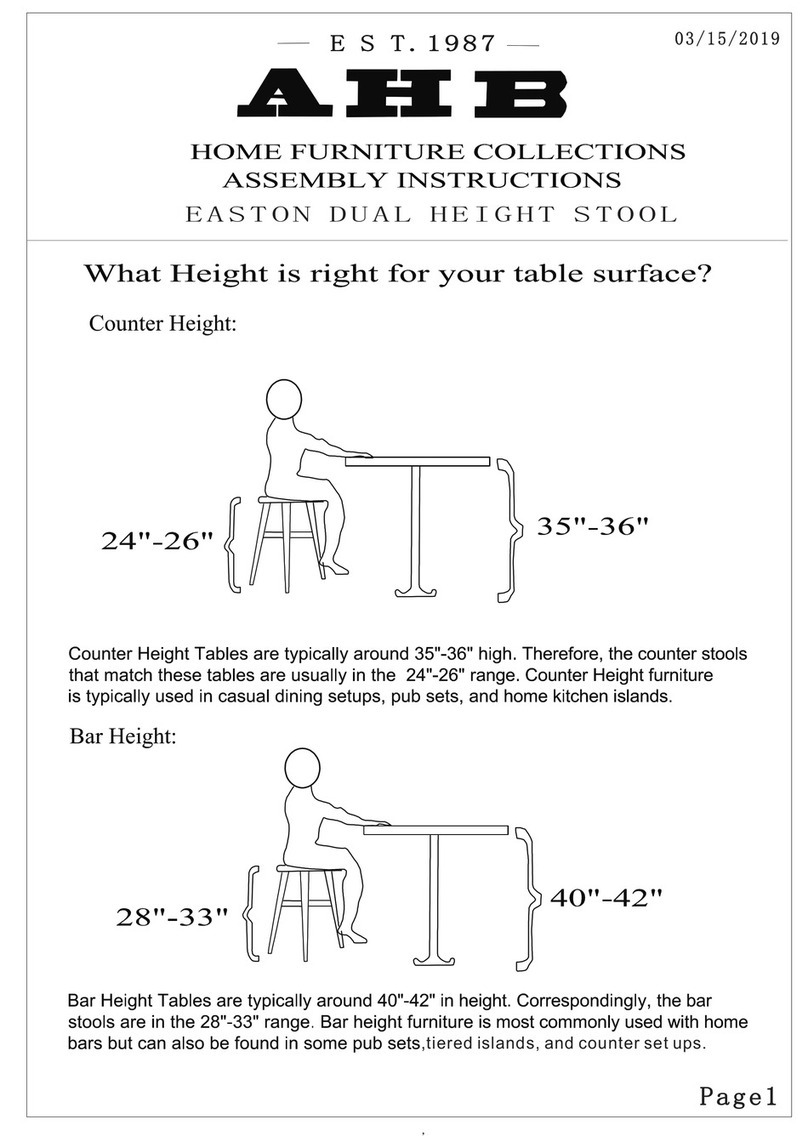
AHB
AHB Home Furniture Series Assembly instructions

IKEA
IKEA IBESTAD instructions

Home Styles
Home Styles 88 5527 08 quick start guide

VISIONARY DESIGNS
VISIONARY DESIGNS VK-1334 Setup instructions
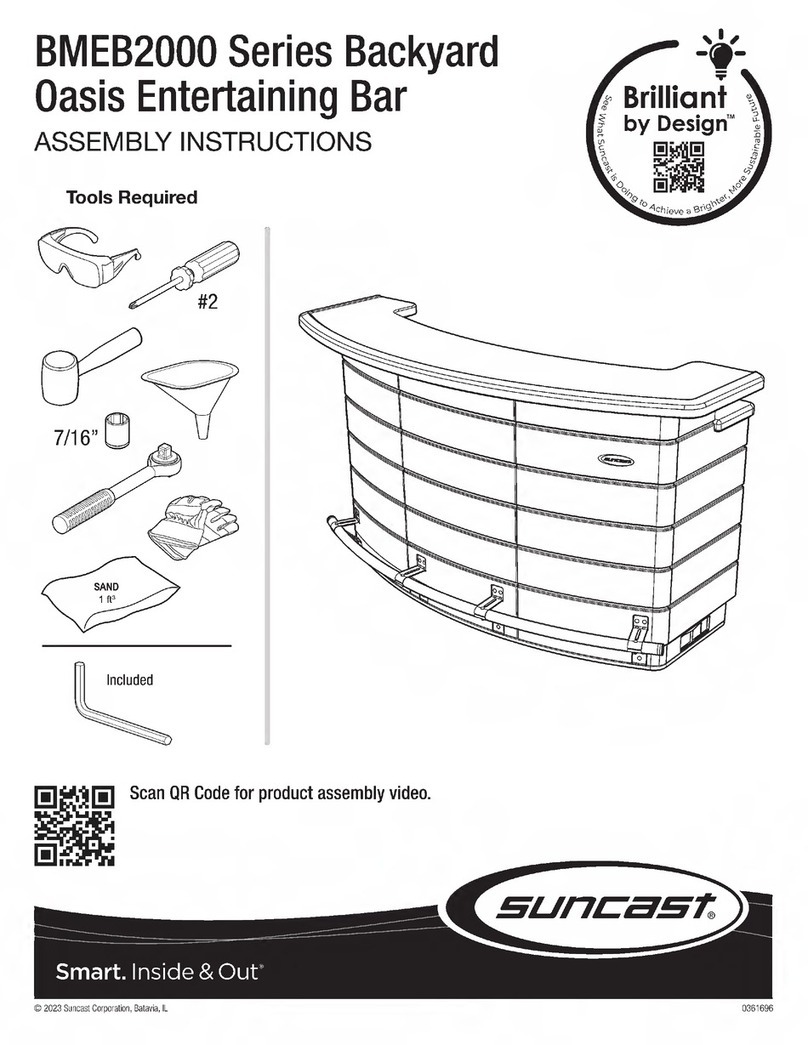
Suncast
Suncast Brilliant by Design BMEB2000 Series Assembly instructions

Lyon Beton
Lyon Beton VERVEINE D-09541 Assembly instructions
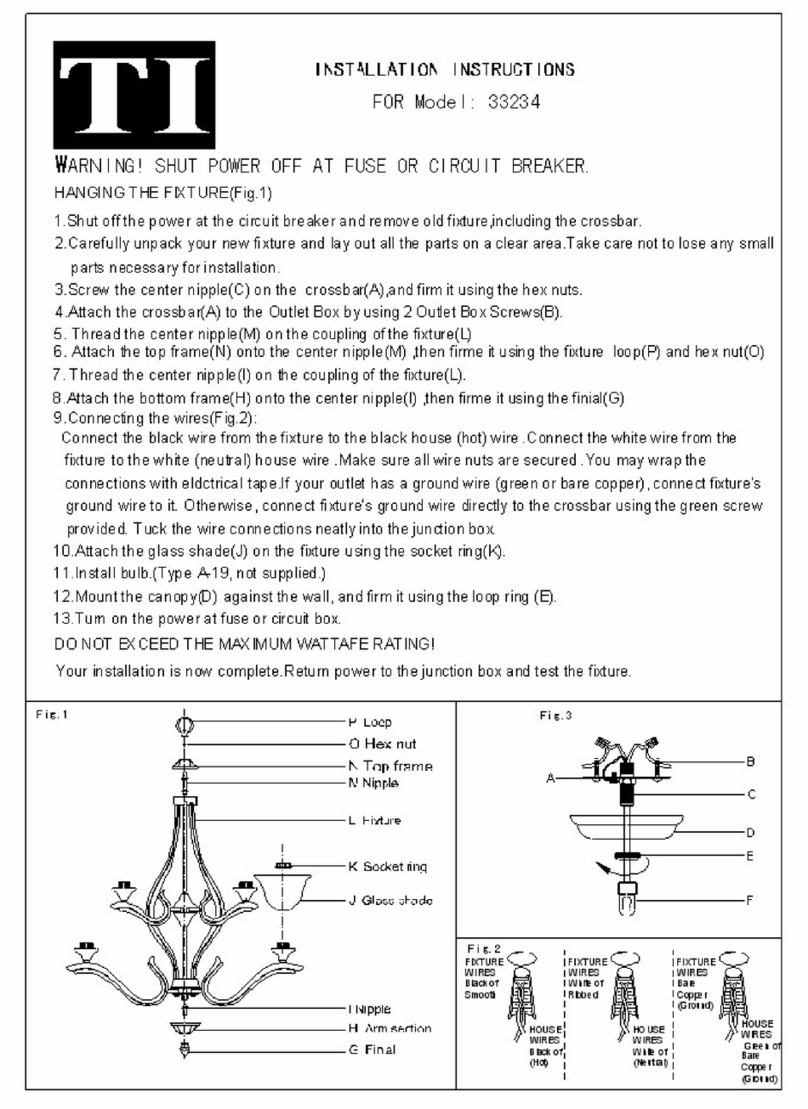
Triarch
Triarch 33234 installation instructions

Bob's Discount Furniture
Bob's Discount Furniture TOWNSEND Assembly instructions

Desalto
Desalto SKIN ALLUNGABILE Assembly instruction
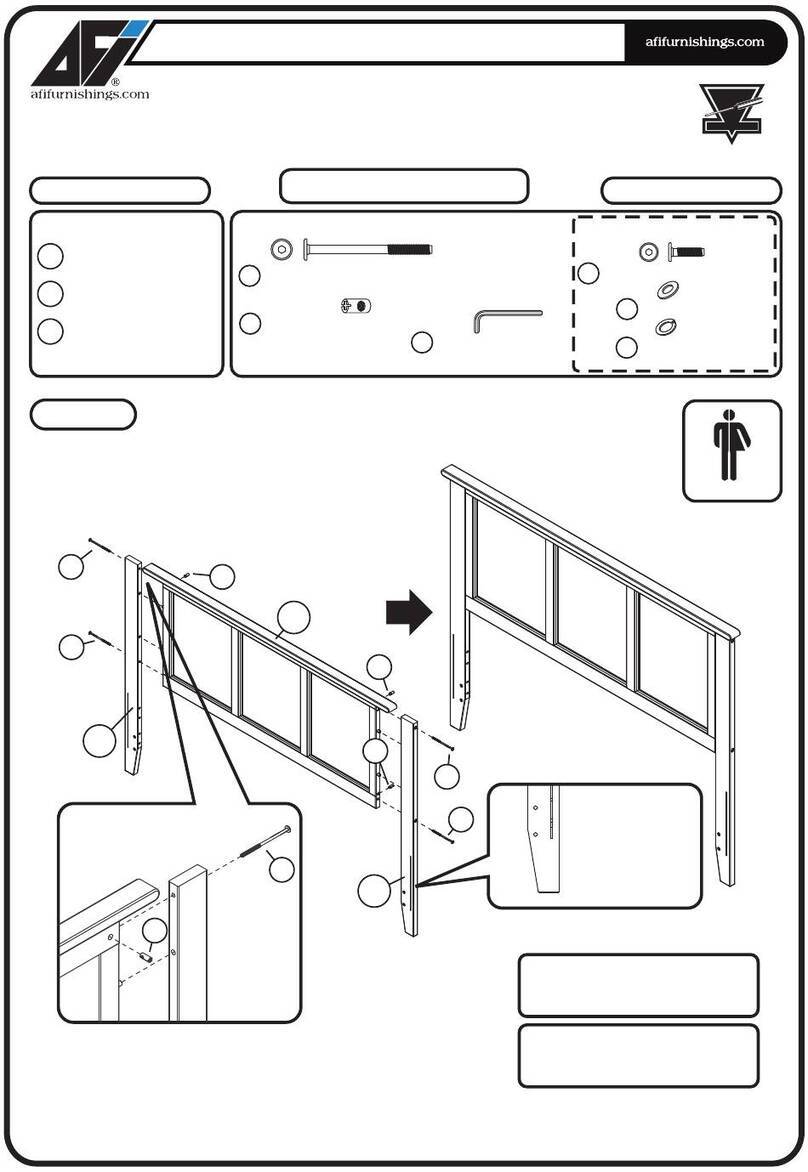
AFi
AFi HB-MDN Assembly instructions

Whittier Wood Furniture
Whittier Wood Furniture McKenzie 2319AFGACc Assembly instructions
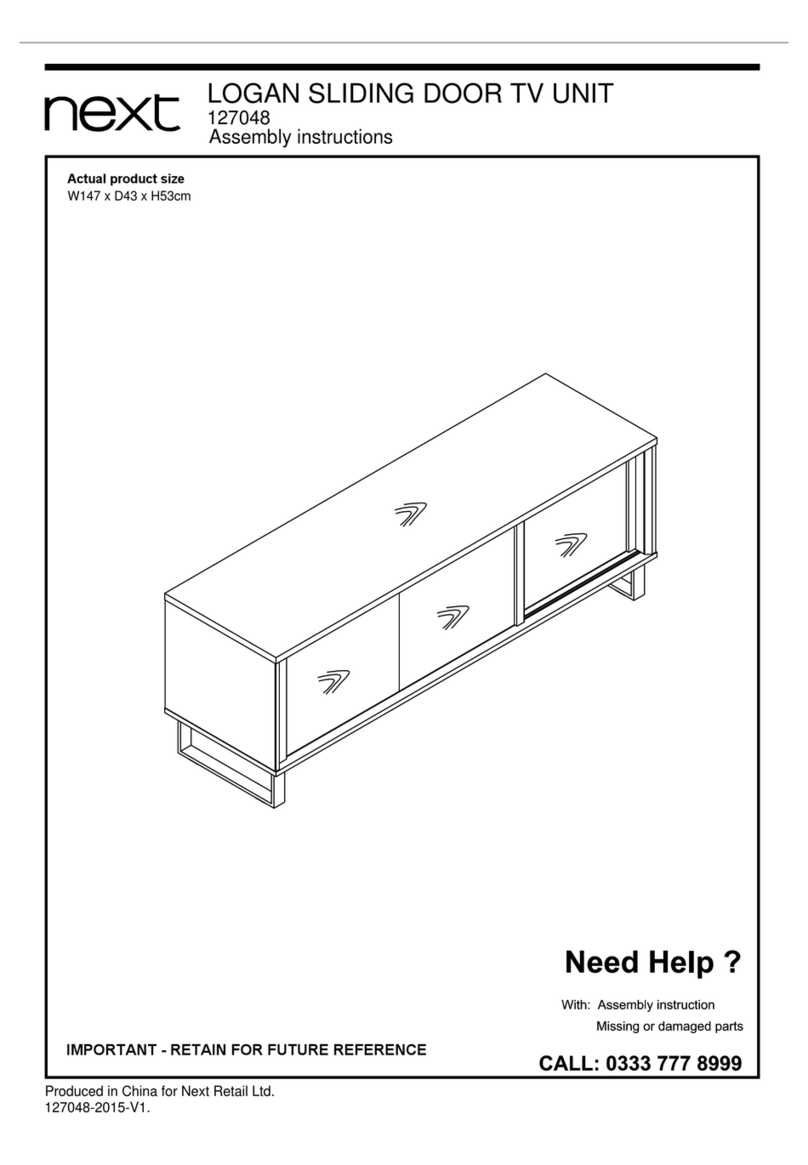
Next
Next 127048 Assembly instructions

